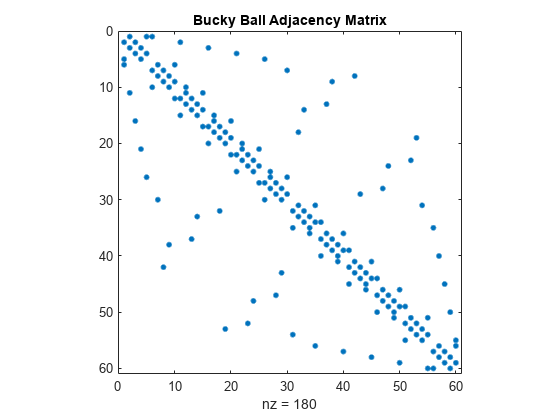图形和矩阵
此示例说明稀疏矩阵的应用并解释了图形与矩阵之间的关系。
图形是一组相互之间具有指定连接或边的节点。图形有许多形状和大小。巴克敏斯特·富勒多面穹顶(也就是足球或碳 60 分子的形状)的连接图就是这样一个示例。
在 MATLAB® 中,您可以使用 bucky 函数来生成多面穹顶的图形。
[B,V] = bucky;
G = graph(B);
p = plot(G);
axis equal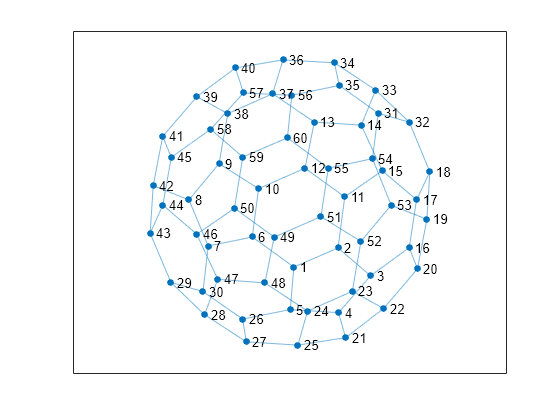
此外,也可以指定节点的坐标,以更改图形的显示。
p.XData = V(:,1); p.YData = V(:,2);

bucky 函数可用于创建图形,因为它返回邻接矩阵。邻接矩阵是一种表示图形中的节点和边的方式。
要构造图形的邻接矩阵,节点应按 1 至 N 进行编号。如果节点 i 连接至节点 j,则 N×N 矩阵的每个元素 (i,j) 都设置为 1,否则设置为 0。因此,对于无向图,邻接矩阵是对称的,但有向图不必如此。
例如,下面展示了一个简单的图形及其关联的邻接矩阵。
% Define a matrix A. A = [0 1 1 0 ; 1 0 0 1 ; 1 0 0 1 ; 0 1 1 0]; % Draw a picture showing the connected nodes. cla subplot(1,2,1); gplot(A,[0 1;1 1;0 0;1 0],'.-'); text([-0.2, 1.2 -0.2, 1.2],[1.2, 1.2, -.2, -.2],('1234')', ... 'HorizontalAlignment','center') axis([-1 2 -1 2],'off') % Draw a picture showing the adjacency matrix. subplot(1,2,2); xtemp = repmat(1:4,1,4); ytemp = reshape(repmat(1:4,4,1),16,1)'; text(xtemp-.5,ytemp-.5,char('0'+A(:)),'HorizontalAlignment','center'); line([.25 0 0 .25 NaN 3.75 4 4 3.75],[0 0 4 4 NaN 0 0 4 4]) axis off tight
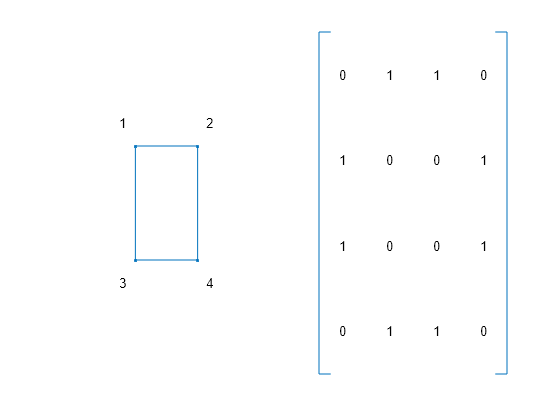
稀疏矩阵特别有助于表示非常大的图形。这是因为每个节点通常只会连接到少数几个其他节点。因此,对于大型图形,邻接矩阵中非零项的密度通常比较小。布基球邻接矩阵就是一个很好的示例,因为它是一个 60×60 的对称稀疏矩阵,仅包含 180 个非零元素。此矩阵的密度仅为 5%。
由于邻接矩阵定义图形,因此您可以使用邻接矩阵中的条目子集来绘制布基球的一部分。
使用 adjacency 函数为图形创建新的邻接矩阵。通过对该邻接矩阵进行索引创建一个新的较小图形,以显示布基球的一个半球中的节点。
figure A = adjacency(G); H = graph(A(1:30,1:30)); h = plot(H);
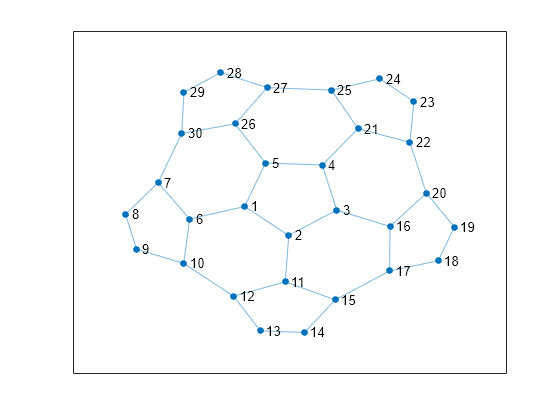
要实现此半球的邻接矩阵可视化,请使用 spy 函数对邻接矩阵中的非零元素的轮廓进行绘图。
请注意,该矩阵是对称的,因此如果节点 i 与节点 j 相连,则节点 j 也与 i 相连。
spy(A(1:30,1:30))
title('Top Left Corner of Bucky Ball Adjacency Matrix')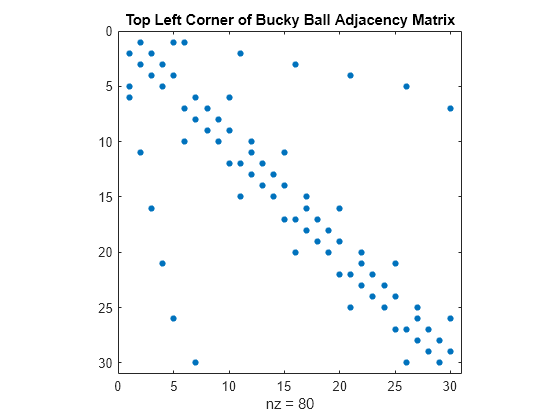
最后,下面展示了整个布基球邻接矩阵的 spy 绘图。
spy(A)
title('Bucky Ball Adjacency Matrix')